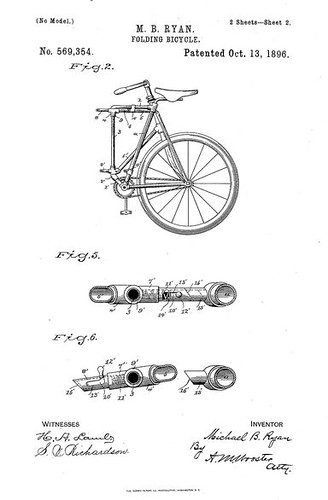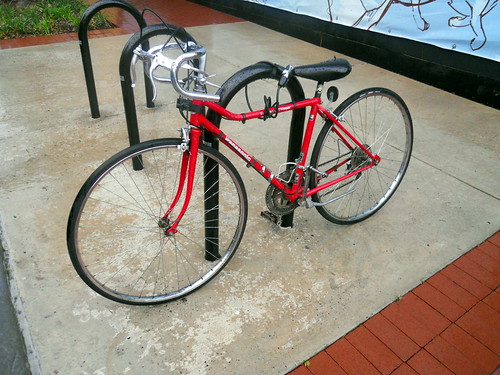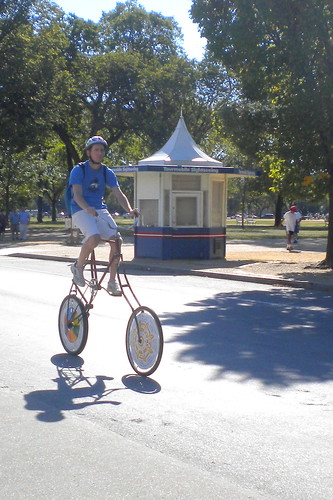This video, in my view, doesn't adequately address all the complexities of what they are proposing
The FUBi Kickstarter project page is the longest one I have ever seen (although I limit myself to looking at Kickstarter projects related to bicycling, so that may be a skewed sample). It is certainly the most ambitious project, in terms of the many novel aspects of the new bicycle they propose to build (and sell, eventually). Their Kickstarter seeks 90,000 British Pounds. (I don't understand why, at least where I live, it is given as in Pounds and not say Euros.) Most of the support so far is from a small number of people wanting to be at the head of the line to receive one when they are first available as a product. With 4,452 Pounds raised and 25 days to go, it doesn't look all that promising (based on what I understand about the usual trajectory for successfully funded Kickstarter projects) but maybe it will work out.

Folding bike patent, 1896 - the interest in folding bikes is of long standing
The FUBi people (or guy?) have a problem, I think - there is no "elevator ride" (that is, brief) way to explain all the aspects of the FUBi bicyclke - this is certainly not just a bike that folds up, but rather a collection of different innovative bicycle technologies, rolled up into a folding bicycle. Here are just some of the unusual (if not novel) aspects to the FUBi design:
* Truss frame design (which is the solution to providing stiffness for this folding bike, but can be a feature of any bike).
* The front and rear wheels have what are described as "an inverted hub as the center of hub is rotating, whereas on a regular hub the axis is fixed and non rotating" - the wheels are identical and only 50 mm wide (compared to 100 mm for a standard road bike front wheel).
* The drive cog set and rear derailleur are outside the chain and seat stays, which is associated with the used of identical narrow front and back wheels.
* The rear (and only) derailleur uses the spring opposite from a traditional modern derailleur - it pulls the chain up onto the larger rings rather than down to the smaller rings (while the rider applies pressure through levers to pull the derailleur in the opposite direction). This is described as a "totally new fast shift derailleur."
* Tension is applied to the chain by a separate system than the derailleur.
* Headset design has the front fork rotating outside of (in front of) the tube where the bearing are.
* The brakes and other aspects of the design are easily adjustable or simply allow use of several different diameter wheel sizes, thus the bike can be said to be usable in configurations ranging from mountain bike to road bike.
* FUBi claims that their bottom bracket, that uses ball bearings mounted directly into the frame and not a cassette is a plus or simplification but I'm not sure most people would see it that way and it isn't particularly unusual (at least not historically).
* And two different ways to fold it up - one fast, another so that it is reduced to the size of tennis equipment bag (and a small one at that - except for the wheels, of course).
I am not an expert of bicycle design and patents, but my impression is that the only piece of this (other than the overall folding design) that is truly new is the "fast shift" derailleur. (And maybe the wheel hub design?) But certainly the amalgamation of all these unusual design features in one folding bicycle is different.
One of 19 (at present) videos on YouTube from "FUBiworld" - how the frame assembles
Kickstarter now requires a "risks and challenges" section to each project proposal be completed - in other words, risks and challenges to the completion of the project if the funding is acquired. The FUBi people talk about some engineering issues, mostly to do with the use of titanium, possible problems with the supply chain for some parts, and building out their team - sure. But a more interesting risk or set of risks for someone putting money into this expecting to get a bike out of it (which is everyone who is putting more than trivial amounts of funding into it) is whether it is a good bike or not. By "good" I mean more than just "does it ride well and all the parts work," but also whether it is easily maintained over the long haul, because a good bike should last a long time. You know, as in at least ten years. To me, to take as obvious both that this bike would ride well and that it will be possible to maintain it in say 2025, seems doubtful - there is risk in particular with the design of the rear derailleur that if FUBi otherwise isn't a success that you end up with a bike that requires a part that isn't available.

A Panasonic Villager - a bike that demonstrates the problems with one-off bicycle innovations that don't catch on
This somewhat sad bike (note the missing left pedal) that I photographed (more for the odd frame design) was considered an innovative bike when made decades ago in that it had its freehub in the bottom bracket and not in the rear wheel - as a result, since no one else adopted this design, these bikes are not easily maintained (other than taking parts off of another example of the same bike). At the same time, the design of the bike is such that reworking the bike to use a standard design is also not possible - much like it would be impossible (I think) to redo your FUBi with a standard rear derailleur.
On the other hand, Kickstarter seems to be much about providing people who have some money they don't know what to do with the opportunity to have something really unusual, if only for a while (that it is unusual). So what the hell. Sure, FUBi.
